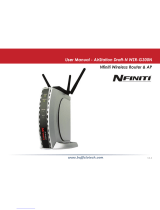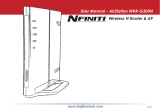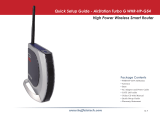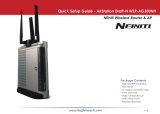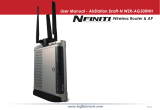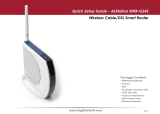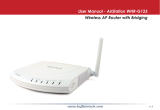Page is loading ...

www.buffalotech.com
User Manual - AirStation WHR-G54S
Wireless Cable/DSL Smart Router
v1.7

2
Table of Contents
Introduction . . . . . . . . . . . . . . . . . . . . . . . . . . . 5
Basic Setup . . . . . . . . . . . . . . . . . . . . . . 6
AOSS Setup . . . . . . . . . . . . . . . . . . . . . . . . . . . 12
Router Access Point Mode . . . . . . . . . . . . . . . . . . . . . . . . . . . 14
AirStation Conguration Tool . . . . . . . . . . . . . . . . . . . . . . . . 17
Home . . . . . . . . . . . . . . . . . . . . . . . . . . . 17
Port Mapping . . . . . . . . . . . . . . . . . . . . . . . . . . . 18
Firewall . . . . . . . . . . . . . . . . . . . . . . . . . . . 19
Windows (MSN) Messenger. . . . . . . . . . . . . . . . . . 20
Encryption . . . . . . . . . . . . . . . . . . . . . . . . . . . 21
Wireless Channel . . . . . . . . . . . . . . . . . . . . . . . . . . . 22
Firmware Update . . . . . . . . . . . . . . . . . . . . . . . . 23
Internet Connection Reset . . . . . . . . . . . . . . . . . . . . . 24
Advanced Tab . . . . . . . . . . . . . . . . . . . . . . . . . . . 25
WAN Conguration . . . . . . . . . . . . . . . . . . . . . . . . 26
WAN port . . . . . . . . . . . . . . . . . . 26
PPP oE. . . . . . . . . . . . . . . .27
LAN Conguration . . . . . . . . . . . . . . . . . . . . . . . 28
LAN Port . . . . . . . . . . . . . . . . . . . . . . . . 28
DHCP Server . . . . . . . . . . . . . . . . . . . . . 29
Manual Assignment of IP Address . . . 30
Network Conguration. . . . . . . . . . . . . . . . . . . . . 31
Route information . . . . . . . . . . . . . . . . . . . . 31

3
Table of Contents
Address Translation . . . . . . . . . . . . . . . . 33
IP Filter . . . . . . . . . . . . . . . . . . . . . . 35
Intrusion Detector . . . . . . . . . . . . . . . . . 38
UPnP . . . . . . . . . . . . . . . . . . . . . . . . . . . 39
Wireless Conguration . . . . . . . . . . . . . . . . . . . . . . . . 40
AOSS. . . . . . . . . . . . . . . . . . . . . . . . . 40
802.11g . . . . . . . . . . . . . . . . . . . . . . 41
Basic . . . . . . . . . . . . . . . . . . . . . . 41
Security . . . . . . . . . . . . . . . . . 42
Repeater . . . . . . . . . . . . . . . . . . . . 43
MAC access limit . . . . . . . . . . . . . . . . . . . . . . . . 44
Admin Conguration . . . . . . . . . . . . . . . . . . . 45
Password . . . . . . . . . . . . . . . . . . . 46
Date /NTP . . . . . . . . . . . . . . 47
Syslog Transfer . . . . . . . . . . . . . 48
Save/Load Conguration . . . . . . . . . . . . 49
Initialize/Reboot . . . . . . . . . . . . . . . . . . . . . . . . . . . 50
Firmware Update. . . . . . . . . . . . . . . . . . . . . . 51
Diagnostic. . . . . . . . . . . . . . . . . . . . . . 52
System Information. . . . . . . . . . . . . . . . . . . . . . 52
Log Info. . . . . . . . . . . . . . . . . . . . . . 53
Packets Info. . . . . . . . . . . . . . . . . . . . . . 54
Client Monitor. . . . . . . . . . . . . . . . . . . . . . 55

4
Table of Contents
Ping Test. . . . . . . . . . . . . . . . . . . . . . 56
Connecting to an existing network. . . . . . . . . . . . . . . . . . . . . . 57
Antenna. . . . . . . . . . . . . . . . . . . . . . 58
Specications . . . . . . . . . . . . . . . . . . . . . . . . . 59
Troubleshooting . . . . . . . . . . . . . . . . . . . . . . . . 64
WDS Bridging . . . . . . . . . . . . . . . . . . . . . . . . 67
Glossary . . . . . . . . . . . . . . . . . . . . . . . . . . . .79
FCC Information . . . . . . . . . . . . . . . . . . . . . . . . 86
Warranty Information. . . . . . . . . . . . . . . . . . . . . 88
Contact Information (USA). . . . . . . . . . . . . . . . . . . . . 89
Contact Information (Europe). . . . . . . . . . . . . . . . . . . . . 90
GPL Information . . . . . . . . . . . . . . . . . . . . . 91

5
Congratulations on your purchase! With both a wired LAN router and a 811g wireless access point,
the AirStation WHR-G54S Cable/DSL Router is perfect for linking your wireless devices with a
wired network and each other.
System Requirements
• A high-speed (Broadband) Internet connection or existing local area connection.
• A computer with a network connection (wired or wireless) and a good web browser. The
screenshots in this manual were taken with Firefox, but Netscape and Internet Explorer
are also supported in versions 4.5 or later, and Safari 1.0 and later are supported with
Macintosh OS X 10.2 and later.
AirStation WHR-G54S Package Contents
The AirStation WHR-G54S package contains the following items:
• WHR-G54S Base Station
• Antenna
• AC adapter and power cable
• CAT5 LAN cable
• Utility CD with Manual
• Quick Setup Guides
• Warranty Statement
Introduction

6
Begin by nding a good place to set up your router/access point. Some things to
consider:
• You’ll need to be able to plug your internet connection into it, so it should go within
reach of the LAN cable from your DSL or Cable modem. You’ll also want a power outlet
nearby.
• Keep the access point as central in your work area as possible. Signal strength and
speed fall off with distance.
• Higher is often better. For instance, set it up on the top shelf of a bookcase rather than
the bottom one, if possible.
Basic Setup
Screw the antenna into the top of your AirStation. For best
performance, align the antenna to point straight up.

7
Make note of the AirStation’s wired MAC address. The LAN
or Wired MAC address is the default SSID (wireless network
name) of the AirStation. You can find it on the bottom of the
AirStation.
You may also wish to contact your ISP to ask if other information, such as global IP address,
subnet mask address, default gateway address, DNS server address, or PPPoE parameters,
is necessary to access your internet connection. Write down any necessary information
that your ISP requires for connection.
Buffalo recommends using a wired network connection, where your computer is physically
connected to the AirStation with a CAT5 straight cable plugged into one of the four LAN ports,
to initially set up your router. This type of setup will eliminate possible setup problems with
the wireless adapter on the computer being used to congure the AirStation.
The computer used to congure the AirStation should be set to obtain an IP address automati-
cally using a DHCP server. The WHR-G54S has a default LAN IP address of 192.168.11.1
and Subnet Mask of 255.255.255.0.
Getting Ready

8
1. Power down the Cable or DSL modem and the computer which will be used to
congure the AirStation router.
2. Plug the Cable or DSL’s LAN Ethernet cable into the AirStation’s WAN port. Initially,
you may need to unplug this cable from your computer, hub or other router.
3. Plug the provided Ethernet cable into a LAN port on the AirStation and plug the other
end into your computer’s Ethernet adapter (NIC). If you plan to initially congure the
AirStation wirelessly (not recommended), you may skip this step.
4. Power on your cable or DSL modem and wait one full minute, then power on the
AirStation router and wait one full minute, and nally, power on the computer which
will be used to congure the AirStation. If the red DIAG light on the AirStation is lit or
ashing after several minutes of being powered on, please consult Buffalo Technology
Technical Support.
Connecting your AirStation

9
Launch a web browser on the computer that you’re
going to use to congure the AirStation.
Enter 192.168.11.1 into the URL eld. Naturally, if you
change your AirStation’s IP address, you’ll have to enter
the new address instead.
A window will open, prompting you to enter a User ID
and Password.
Enter root as the User name and leave the password
eld blank.
Log in to the Configuration Tool

10
Your AirStation’s SmartRouter technology will determine the type of internet
connection you have automatically, and ask you for any needed information. If
your ISP assigns IPs automatically (most cable providers do), their DHCP server
will give your router an IP address. If additional login information is required
to connect to the internet, the wizard will ask for it. Enter any required login
Detecting Your Broadband Connection
information if asked. Contact your DSL
provider for any missing login information.
If your DSL provider requires that PPPoE
information be entered manually, see page
25.

11
This is the opening page of your
AirStation’s conguration tool. You
can always get to it from within the
conguration screens by clicking on
Home. From here, you can congure
port mapping for your internet games,
turn on UPnP for Windows (MSN)
Messenger, congure your Firewall,
setup Encryption, choose your Wireless
channel, update your AirStation’s
rmware, and reset your Internet
connection’s conguration. As you
explore the conguration tool, you can
usually get context sensitive help by clicking on the Help link at the top right of
the page.
To go to Advanced Settings (page 25), click on the Advanced tab. To get the
system information you need to set up a wireless client that doesn’t support
AOSS, click on the System Info tab. See page 17 for more on Home.
Home

12
AOSS
AOSS (AirStation One-Touch Secure System) is a simple system for
conguring your wireless network securely. If your router and your client
device are connected and both support AOSS, then making a secure wireless
connection is very easy.
Push the AOSS button on the top of your router and hold it in for a few
seconds. The AOSS light will begin to ash amber. You now have two minutes
to push the AOSS button on your client device and nish the connection.
If you have a standalone client device,
it will probably have a little red button
labled “AOSS” on it. Push the button!
About 15 seconds later, you’ll have a
secure network connection.
If your client device is a PC card,
CardBus, or PCI adaptor, the AOSS
button will probably be in its Client
Manager Software. Check your client
device’s user manual for instructions
on where to push or click the AOSS
button.
After you’ve pressed both buttons, it will take about 15 seconds for the connection to
complete. When it’s nished, the AOSS light witll glow a solid amber. You now have a
secure network connection!
standalone cli-
ent device
PC card Client Manager
Software
AOSS

13
Some things to keep in mind
• Only one AOSS wireless client adapter can be congured with the AOSS router at a
time. The buttons will need to be re-pressed to connect each additional AOSS wireless
client adapter.
• It is not necessary to AOSS client devices that have already been congured via AOSS,
unless signicant changes have been made to the wireless network.
• Do not attempt to congure two separate AOSS networks at the same time, as it may
cause undesired congurations.
• If an undesired client has connected via AOSS, it can be disconnected from within the
WHR-G54S’s advanced conguration menus.
AOSS Notes

14
This AirStation supports quickly changing the
product from a wireless router to a conventional
access point.
Put your Airstation into Access Point Mode
by moving the switch on the bottom of your
AirStation from AUTO to BRI. This changes
the default IP address of the AirStation from
192.168.11.1 to 192.168.11.100, and DHCP,
NAT, and the WAN port are disabled.
Access Point Mode might be desirable if you’re adding wireless capability to an existing
network with a router. It is not suitable for most home congurations. If you plan to
use the AirStation as an normal wireless router, make sure that this switch is in the normal
(AUTO) position!
To set up your AirStation as a bridge or repeater, turn to page 43.
Router/Access Point Mode

15
If your wireless client doesn’t support
AOSS, you’ll have to congure it
manually. From the Home page, click
on the System Info tab.
Manual Client Configuration

16
This page gives you all the
information you might need to
congure your non-AOSS wireless
client. Probably you’ll just need
the SSID, encryption type, and
password. Consult your wireless
client’s documentation for more
information on conguring it if
necessary.
You can get here from Home by
clicking the System Info tab.
System Info

17
AirStation Configuration Tool (Home)
When you rst open your AirStation
Conguration Tool, it will take you to Home
(see also page 11). From Home, you can
congure port mapping for your internet
games, set UPnP for Windows (MSN)
Messenger, congure your rewall, setup
encryption, choose your wireless channel,
update your AirStation’s rmware, and reset
your Internet Connection’s conguration.
Clicking the Advanced tab gives you access
to all of the AirStation’s conguration tools.
You can get back to Home from anywhere
in the management tool by clicking on the
Home button at the top left of the screen.
Let’s begin exploring advanced settings by
clicking on Internet Games (Port Mapping).

18
Internet Games (Port Mapping)
Select any ports that need to be
opened for your internet games to
function correctly. Consult your
game’s documentation for more
information on what ports need to be
congured.

19
Windows (MSN) Messinger/UPnP
Windows (MSN) Messinger requires
UPnP for proper operation. You may
Enable UPnP here. UPnP may need to be
congured on your PC as well.
If you need to congure UPnP on your PC,
the links at the bottom of the page have
instructions for doing so on Windows ME
and XP computers.
Get to this page from Home by clicking on
Windows (MSN) Messinger.

20
Firewall/Intrusion Detector
From this page, choose the level of rewall
security you desire. You may also choose
to have alerts sent to a different PC, if you
like. Click Next when done to restart the
router.
Get to this page from Home by clicking on
Firewall/Intrusion Detector.
/
